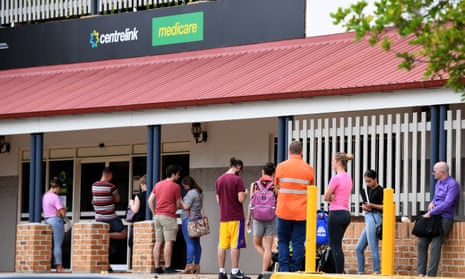Halving welfare benefits after the coronavirus pandemic would reduce the number of affordable rentals across Australia for single jobseekers from more than 1,000 to nine, a new report has found.
Anglicare’s annual Rental Affordability Snapshot, released on Thursday, found that 1,040 of the 69,960 homes surveyed would be affordable for a single jobseeker after the government boosted welfare payments by $550 a fortnight.
But if the temporary coronavirus supplement is scrapped in six months, only nine of those homes would be considered affordable according to a 30% of income benchmark.
The report was released just as the government faces growing pressure to boost to base rate of jobseeker payments, which have not been increased in real terms in 25 years.
Examining rentals advertised on 21 March, Anglicare found that a couple on jobseeker payment with two children would see the number of affordable rentals fall from 8,106 (11.6% of all properties) to 589 (0.8%) if the supplement was cut.
Meanwhile, disability support pensioners, who are excluded from the supplement, could find only 245 or 0.4% of rental properties within reach for a single person.
Anglicare became one of the first social service organisations to call on the government to make the $550 a fortnight supplement permanent as it released the findings.
“Government welfare benefits are simply not enough for people to live on in the private rental market,” the executive director, Kasy Chambers, told Guardian Australia.
“When you look at how these numbers pan out, you can clearly see even with the coronavirus supplement the cost of living for people is unreachable on benefits. We have to keep them the same.”
Chambers said the supplement should also be extended to people receiving the disability support pension, carer payment and aged pensioners. The Guardian first highlighted their exclusion in March.
In the capital cities, the contrast was even more stark. While there were 375 affordable rental properties in Sydney for an unemployed couple with two children, that would reduce to zero without the coronavirus supplement.
The single rate of the jobseeker payment has been boosted from $565.70 a fortnight to about $1,115.70 with the introduction of the supplement. Anglicare’s calculations include supplementary payments such as rental assistance and family tax benefit, which are paid to parents.
Parenting payment single recipients, who receive a base rate of $790.10, would be able to afford only 395 rental properties without the supplement, down from 2,109, according to the snapshot.
Last week, the Nationals MP Pat Conaghan said the supplement should last 12 months, rather than six months, while the opposition and the Greens are also calling for a permanent boost to the dole.
The Labor MP Lisa Chesters went further this week to argue the doubled rate should be permanent, while the Tasmanian independent senator Jacqui Lambie said scrapping the boost would be “heartless”.
The former prime minister Tony Abbott has also offered qualified support for the $550 a fortnight supplement to be made permanent.
But asked on Wednesday, Scott Morrison insisted the supplement was a “temporary” emergency measure.
“This was not change, in the government’s view, about the broader role of the social safety net in Australia,” the prime minister said.
The Guardian reported on Monday that capital city rental prices had fallen by 3.1% over the past week, while vacancies are up as some tenants who were unable to afford their tenancies bailed out of the market.
However, the data masked huge falls in the plusher areas such as Sydney’s eastern suburbs and the CBD.
Chambers said that although overall rents might decrease in the coming months, this rarely affected properties at the bottom of the market. “Some of the really expensive properties might come down, but that bottom level seem to stay.”
